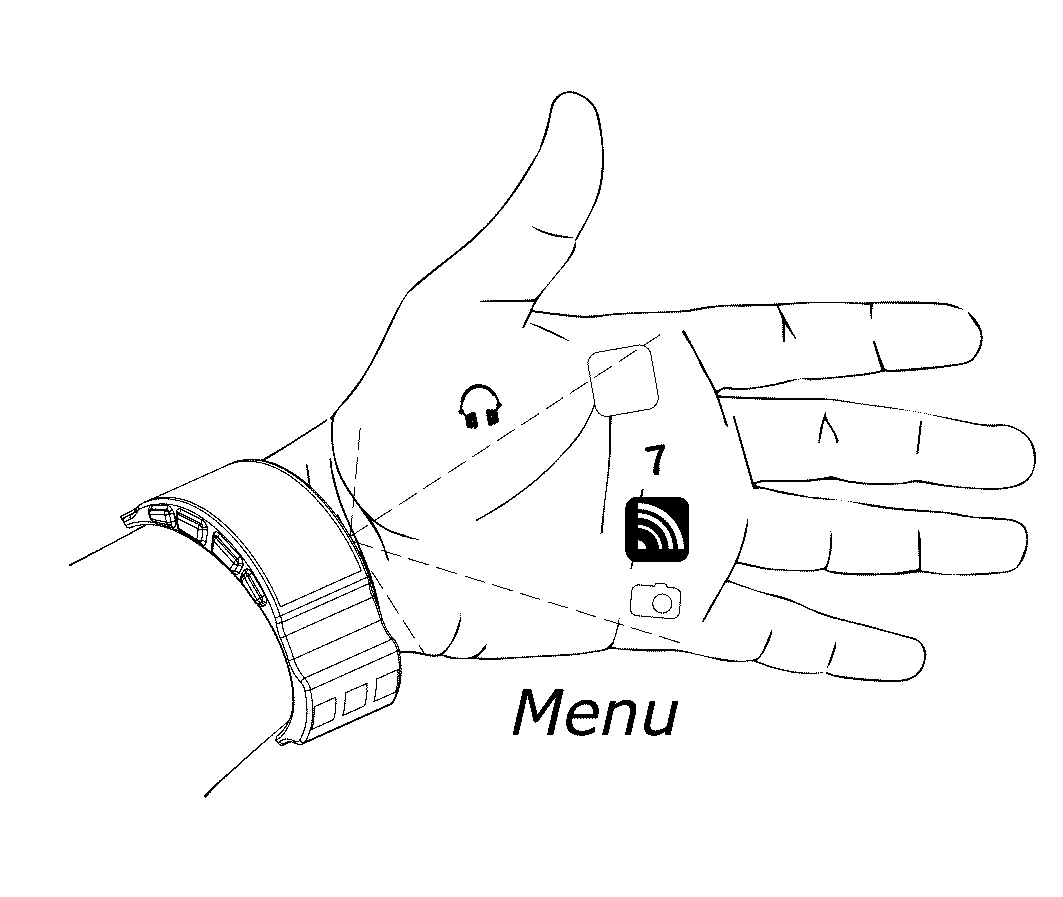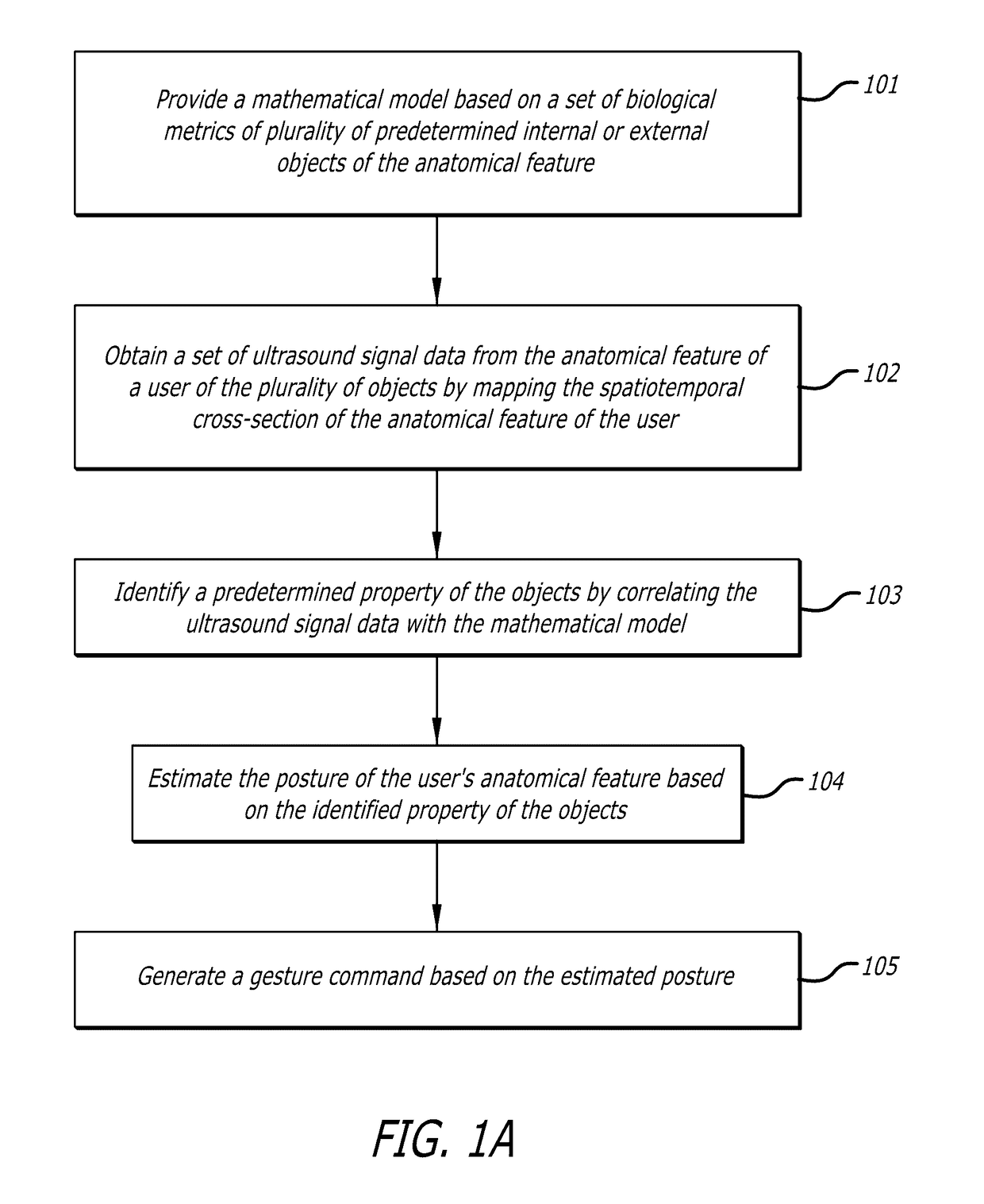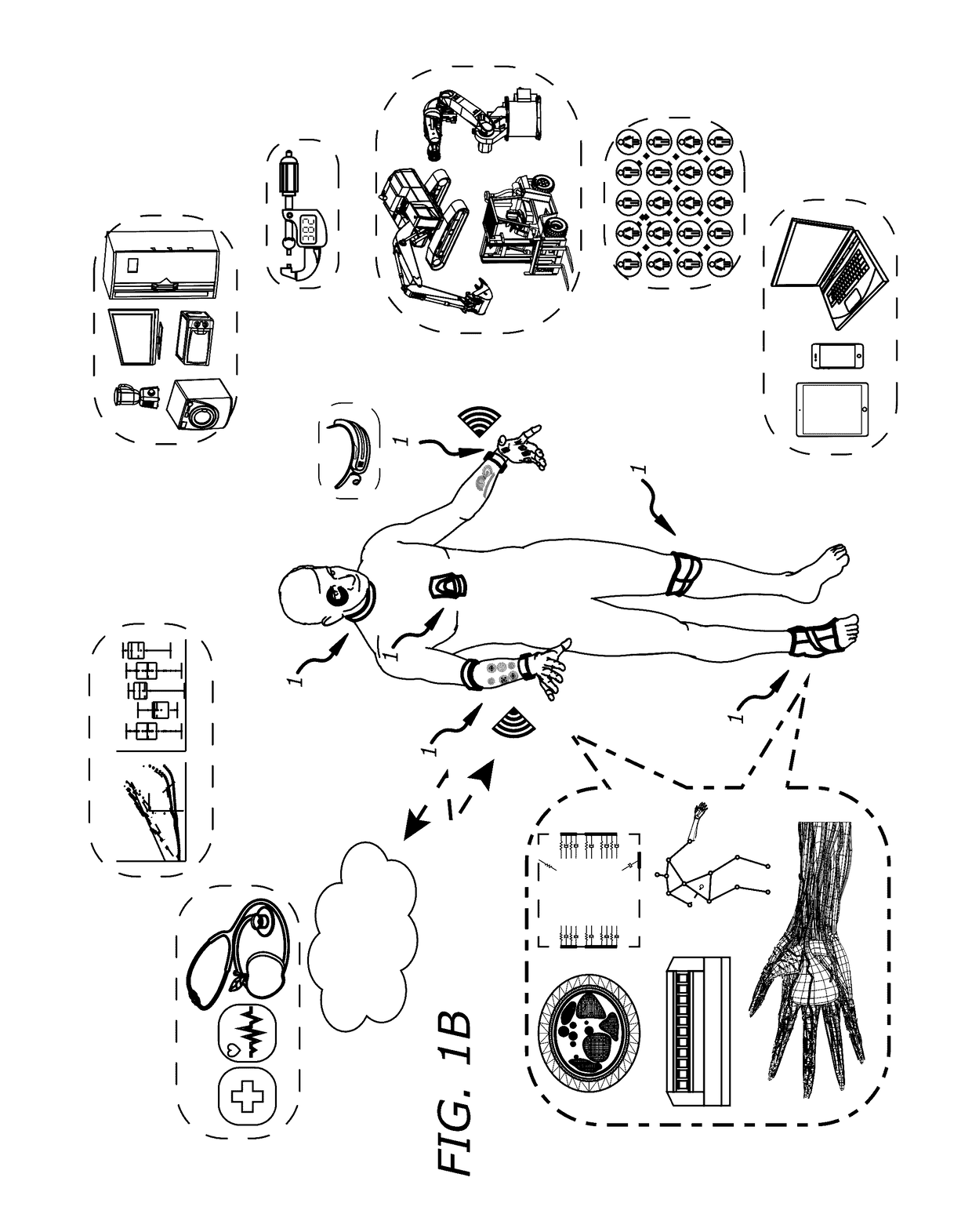Despite these advances, the transmit bandwidth remains limited as a result of non-intuitive mechanical interfaces or limited alphabet gestural interfaces that require training to develop proficiency in.
This in turn creates problems where users that are used to large displays don't find it convenient to use or interact with much smaller displays, resulting in wearable devices that have both a low transmit as well as a low receive bandwidth.
A wearable system that requires interactions with multiple buttons or touch elements before extracting useful content therefore fails to translate the
advantage conferred by such intimacy.
Display space available for wearable computing machinery is also remains limited.
The aesthetic challenge of constructing a display large enough to be
usable as a wearable device cannot be solved using existing display approaches.
Nonetheless, the related information bandwidth is proportional to screen size and resolution such that small screen sizes and restrictions on human
visual acuity limit the total information that can be transferred by conventional
wearable technology.
Input technologies face similar restrictions and challenges.
Unfortunately, the average available tactile area for users (from fingers) remains constant and
miniaturization of tactile keys is not possible beyond a limited range.
Touch capability also becomes difficult to implement on increasingly smaller screen sizes used in wearable devices.
Other input technologies are in various states of maturation, but largely use statistical methodologies to estimate
user intent, generally resulting in a degraded user experience.
1. These conventional approaches tend to capture user image information along with
background image information and require significant hardware and
software /
processing effort to distinguish between the two. Distinctions are frequently made using statistical assumptions that show great variance.
2. These same approaches frequently fail to capture all of the input data required to estimate a posture of an anatomical feature because critical information is involuntarily occluded or not sensed by the image devices.
3. These approaches place restrictions on user clothing (e.g., no gloves, no sleeves, rings) and these approaches can be misled by objects in the user's hands and cannot be used by amputee users or those with certain medical disabilities.
4. In conventional applications that incorporate an external sensing scheme, such systems are not easily portable and related sensors must be affixed at very specific positions with respect to the user.
5. Many conventional solutions lead to repetitive strain injuries commonly known as “gorilla arm” and can be physically demanding on a user.
6. Conventional
gesture recognition solutions often place restrictions on the
user environment (
clutter, background illumination, location of sensor with respect to floors) in order for the sensors to work accurately and many systems
restrict a user's movements to be within specific locations or boundaries.
7. Conventional
machine-vision approaches generally provide little or no feedback to the user in terms of what the actual
field of view of the sensor is. This frequently leads to
confusion when the user inadvertently steps out of the region accessible by the sensing camera.
8. Conventional
machine-vision systems may use multiple camera setups and capture redundant datasets. This in turn, increases hardware requirements and latency even though a majority of the data is eventually discarded as background, reducing sensor efficiency and
wasting processing power.
9. Conventional optical gesture-recognition systems also frequently experience artifacts that must be processed individually (for example, those from
motion blur, lensing distortions, shadowing and illumination).
The primary limitation with such a system is the requirement of wearing an uncomfortable and obtrusive glove-like system in which the elasticity of fabrics used in the glove design may negatively affect the posture estimates of the anatomical feature.
1. Such methods can only be used discriminatively. New gestures or tap locations cannot be distinguished, thus restricting both the resolution and the available number of gestures such systems can recognize.
2. Due to the
vibration transmission requirement, this approach limits the apparel a user can wear while using such a system.
3. Bioacoustic systems require the use of two hands.
4. Sensors used in bioacoustic systems can only be placed at certain body locations based on tissue densities.
Invasive techniques to extract these signals, as are used in micro-electrocorticography, are not practical since they require surgeries or
insertion of needle electrodes for placement and are only used as last-resort, condition-of-life improvement options.
A practical problem for such
gesture recognition approaches is that the science behind the generation of these signals is not yet well understood and most gesture recognition algorithms operate discriminatively.
This limits the total number of gestures that can be recorded by such systems.
Another deficiency in these conventional approaches is that the related signals have very poor
signal-to-
noise ratios, leading to
poor posture estimates.
Because the required surface electrodes pick up averaged inputs from multiple tissues in different locations in EEG / EMG, these systems have a tendency to reduce the accuracy of gesture discrimination and also require the sensors be situated in regions with heavy electrical activity.
The overall issues with accuracy and limited gesture discrimination capabilities of these systems tend to
restrict their use to commercial applications.
Lastly, there are conventional inertial measurement and attitude and heading reference-based posture sensing systems that have been attempted but which suffer from many or all of problems earlier discussed in other conventional gesture recognition attempts.
None of these disclosures account for pressure applied by mechanical fixtures or external contact while the device is being worn.
Such tissue rearrangements occur inconsistently between multiple wear-remove cycles and consequently affect
ultrasound signal characteristics that are received from the anatomical feature.
The attempts disclosed in the above references do not teach any method to control or mitigate the effects of the mechanical stresses on body internal objects and tissues that are generated by such fixtures.
Pressure against the upper arm above the
elbow region significantly affects the signals through
skin and causes
tissue deformation of objects within the feature.
Consequently, minor rotational articulations of ultrasonic
transceiver arrays resulting from slips or inconsistencies in re-placement of the transceivers can undesirably result in very large
signal variations.
Another issue in gesture recognition applications is inertially-induced motion (including both static and vibratory deflections) in body tissues.
The
inertial mass represented by the
transceiver itself will influence inertial responses in the tissues in their immediate vicinity, potentially degrading
signal quality due to mechanical deformations of the tissue under inertial loading.
This is a particular problem when using a wearable
ultrasound probe at the wrist that utilizes convex acoustic lensing, as this can cause the probe to rotate away from the cross-section of interest or to move in place.
Human digits and body parts have substantial
mass and their tissues are not stiff enough to
resist involuntary deformation under the effects of gravity.
Such involuntary deformations lead to problems in precise gesture recognition in all modalities.
Ultrasound devices that require long-term insonification of tissues must pay attention to safety and provide fail-safe designs, although the conventional approaches discussed herein do not directly address safety-first design considerations.
There exist some, for example, 1-3 or 2-2 piezoelectric composites, that provide improved
impedance matching however such devices don't address the air-
skin contour barrier and leakage through it.
Obviously, the use of gels or oils is extremely inconvenient and not fitted for practical use.
A critical flaw these conventional approaches is they require a labeled, prior-training dataset where a user “classifies” or, for example, defines what it means to have a forefinger fully flexed.
Users can rarely reproduce gestures with precision, leading to cumulative biases.
This requires users to retrain the
software and restricts users to certain pre-defined gestures.
Such statistically-defined gestures where a computer doesn't naturally recognize a forefinger from a
thumb, leads to frustrating
user interface interactions.
Another problem in such approaches is that they are “referential” or discriminative and not generative.
They thus have very limited alphabet sizes (i.e., total number of gestures that an implementation of an
algorithm can distinguish between from the entire set of gestures and postures that users can actually generate) that are exactly defined by the gestures used during training.
These gestures cannot be combined in ways to recognize a new gesture obtained from a combination of other gestures.
This leads to two issues: One where detection of a gesture in every
image frame requires computing scores over the entire training corpus, which leads to more computational complexity and decreased frame-rates with increased latency.
And the second where large training datasets also force users to spend a longer time training the
algorithm, which is tedious and unacceptable in commercial products.
A critical problem with the disclosed approach is that specific locations of anatomical components are not consistently referenceable with respect to the landmarks across the
population and they may not be visible throughout the measurement process.
Therefore, pre-targeting based on static landmarks does not work well for algorithms for gesture recognition.
This process introduces spatial and temporal interpolation and
aliasing artifacts, does not directly represent or take
advantage of the raw US data obtained from the echography nor is
scan conversion even required in non-imaging applications.
Such
image formation /
scan conversion introduces unwanted hardware and latency overheads; for example, memory buffers to store frames and the time to store, retrieve or access the buffers.
Additionally, none of the above-discussed gesture recognition references teach the use of
radiography techniques in any diagnostic or general healthcare modalities.
Furthermore, none provide interface technologies that are explicitly a part of their gesture recognition algorithms beyond simple message display.
There are several problems unique to the implementation of U.S. Pat. No. 8,292,833.
Wrist or
elbow articulation about either
pitch, roll or
yaw axes results in deformations at the
carpal tunnel resulting in apparent motion of the tendons as well.
Accordingly, acquired signals suffer from heavy sympathetic masking and
aliasing in this approach.
Since the extensor tendons do not normally pass through the
carpal tunnel and since
muscle groups engaged in digital articulation such as abductor pollicis brevis or lumbricals, this in effect severely limits the actual postures that can be sensed with such an approach.
In general, due to the under-determined nature of such systems, inertial measurement alone cannot solve such problems.
Micro emissive
OLED technology is not considered a useful modality for pico projection since it does not generate sufficient light output or brightness for practical projection to take place.
DLP / LCoS both require combinations of illumination LEDs, collimation
optics, combination
optics, homogenizers, beam-splitters, polarization recirculation systems, all in addition to
spatial light modulator units,
projection optics assemblies, power driver integrated circuits and pixel modulation integrated circuits—these introduce constraints on minimum volumetric footprints that such light engines can have.
Laser scanning technologies have issues with speckling that require the use of optical and photonic diversity to reduce
speckle contrast in the projected images and require the use of additional hardware.
LEDs and
laser diodes used as illumination sources in such systems take up volume and require extensive thermal management subsystems.
Sizes of such devices can only be managed by reducing the total light output of such systems and even then, the system volume cannot practically be reduced much further, limiting adoption in wearable technology systems.
As is apparent, conventional wearable gesture recognition and projection systems are based on technologies that do not conform well to wearable
device form-factors or are severely restricted in allowable designs.
This also constrains the design of systems with multiple embedded pico projection elements and restricts designs to those intended for displaying projected images on a single surface.
Conventional attempts do not consider that many projection surfaces (e.g.,
human skin) have inconsistent optical characteristics.
Screen-
gain and ambient illumination are already significant challenges for on-wall projection displays and are generally solved by using
high intensity lamps, and on-body projection constrains make such display quality even more challenging.
Any motion of tendons under the
skin surface and any soft-
tissue deformation causes the reflection of projected light in multiple directions, creating loss in contrast as well as loss of efficiency and brightness.
The problem becomes more difficult if the body part upon which the display is projected undergoes a posture change during display.
But on-body surfaces will likely have multiple non-linear curvatures and none of the conventional approaches account for this.
Accounting for such non-linear curvatures requires conversion of
image resolution from linear to non-linear and must be accounted for physically in the display technology or by using
software warping algorithms which are known to reduce the effective resolutions used in such displays.
Certain conventional approaches claim to use gesture recognition technologies that do not return information about actual
tissue deformation.
Accordingly, these conventional solutions do not provide
high resolution means to account for posture-induced, soft-tissue deformation.
This limits these approach's interaction modalities and projection capabilities greatly.
 Login to View More
Login to View More  Login to View More
Login to View More 


